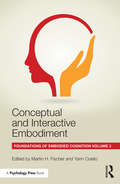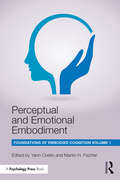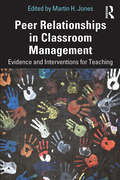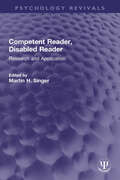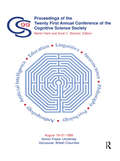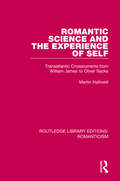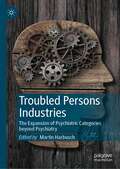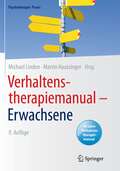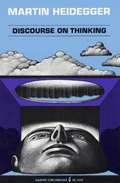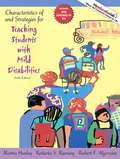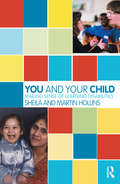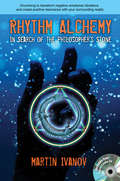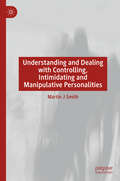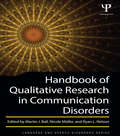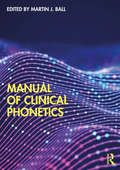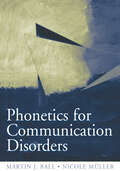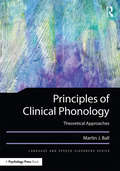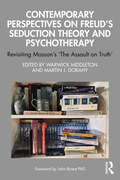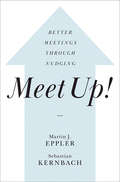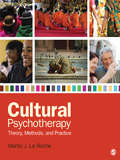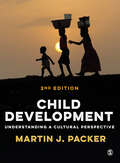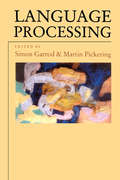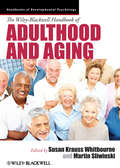- Table View
- List View
Conceptual and Interactive Embodiment: Foundations of Embodied Cognition Volume 2
by Martin H. Fischer Yann CoelloThis two-volume set provides a comprehensive overview of the multidisciplinary field of Embodied Cognition. With contributions from internationally acknowledged researchers from a variety of fields, Foundations of Embodied Cognition reveals how intelligent behaviour emerges from the interplay between brain, body and environment. Drawing on the most recent theoretical and empirical findings in embodied cognition, Volume 2 Conceptual and Interactive Embodiment is divided into four distinct parts, bringing together a number of influential perspectives and new ideas. Part one introduces the field of embodied language processing, before part two presents recent developments in our understanding of embodied conceptual understanding. The final two parts look at the applied nature of embodied cognition, exploring the embodied nature of social co-ordination as well as the emerging field of artificial embodiment. Building on the idea that knowledge acquisition, retention and retrieval are intimately interconnected with sensory and motor processes, Foundations of Embodied Cognition is a landmark publication in the field. It will be of great interest to researchers and advanced students from across the cognitive sciences, including those specialising in psychology, neuroscience, intelligent systems and robotics, philosophy, linguistics and anthropology.
Perceptual and Emotional Embodiment: Foundations of Embodied Cognition Volume 1
by Martin H. Fischer Yann CoelloThis two-volume set provides a comprehensive overview of the multidisciplinary field of Embodied Cognition. With contributions from internationally acknowledged researchers from a variety of fields, Foundations of Embodied Cognition reveals how intelligent behaviour emerges from the interplay between brain, body and environment. Covering early research and emerging trends in embodied cognition, Volume 1 Perceptual and Emotional Embodiment is divided into four distinct parts, bringing together a number of influential perspectives and new ideas. Part one opens the volume with an overview of theoretical perspectives and the neural basis of embodiment, before part two considers body representation and its links with action. Part three examines how actions constrain perception of the environment, and part four explores how emotions can be shaped and structured by the body and its activity. Building on the idea that knowledge acquisition, retention and retrieval are intimately interconnected with sensory and motor processes, Foundations of Embodied Cognition is a landmark publication in the field. It will be of great interest to researchers and advanced students from across the cognitive sciences, including those specialising in psychology, neuroscience, intelligent systems and robotics, philosophy, linguistics and anthropology.
Peer Relationships in Classroom Management: Evidence and Interventions for Teaching
by Martin H. JonesPeer Relationships in Classroom Management offers pragmatic, empirically validated guidance to teachers in training on issues pertaining to students’ interpersonal relationships. Concepts such as bullying, popularity, and online friendships are ubiquitous in today’s schools, but what kinds of scientific and pedagogical knowledge can support teachers navigating students’ complex lives? Using real-world examples and case studies, this book helps preservice educators to enhance their knowledge of classroom management by focusing on the interpersonal relationships in their schools. Each chapter includes an accessible approach to understanding the social motives in student’s peer interactions inside school, and how to best intervene when these social interactions become detrimental to learning or cause negative interpersonal interactions.
Competent Reader, Disabled Reader: Research and Application (Psychology Revivals)
by Martin H. SingerIn the past frustration with experimental reports had caused educators to dismiss the entire reading research enterprise. Originally published in 1982, this book attempts to abstract those experimental results relevant to developing effective reading programs. The book concentrates on the more mechanical aspects of reading skill such as visual discrimination ability, visual and auditory memory, visual-to-phonetic translation skills, and attentional strategies. These skills it is argued, account for the major proportion of variance in reading ability. The research on both competent and incompetent reading indicates the special importance of such skills to reading. The book contains three sections. Section I reviews the experimental evidence on competent reading. The review highlights consistent threads of evidence and provides a description of the competent reader’s strategies for analyzing text. Section II reviews research on poor reading. This section evaluates the concept of dyslexia and stresses that reading problems are not uniform. Section III maintains that the information about competent reading strategies and the impediments to acquiring those strategies should guide educators in evaluating instructional materials and facilitate the diagnosis of reading failure. Today it can be read in its historical context.
Proceedings of the Twenty-first Annual Conference of the Cognitive Science Society
by Martin Hahn; Scott C. StonessThis book presents the complete collection of peer-reviewed presentations at the 1999 Cognitive Science Society meeting, including papers, poster abstracts, and descriptions of conference symposia. For students and researchers in all areas of cognitive science.
Romantic Science and the Experience of Self: Transatlantic Crosscurrents from William James to Oliver Sacks (Routledge Library Editions: Romanticism #Vol. 2)
by Martin HalliwellFirst published in 1999, this engaging interdisciplinary study of romantic science focuses on the work of five influential figures in twentieth-century transatlantic intellectual history. In this book, Martin Halliwell constructs an innovative tradition of romantic science by indicating points of theoretical and historical intersection in the thought of William James (American philosopher); Otto Rank (Austrian psychoanalyst); Ludwig Binswanger (Swiss psychiatrist); Erik Erikson (Danish/German psychologist); and Oliver Sacks (British neurologist). Beginning with the ferment of intellectual activity in late eighteenth-century German Romanticism, Halliwell argues that only with William James’ theory of pragmatism early in the twentieth century did romantic science become a viable counter-tradition to strictly empirical science. Stimulated by debates over rival models of consciousness and renewed interest in theories of the self, Halliwell reveals that in their challenge to Freud’s adoption of ideas from nineteenth-century natural science, these thinkers have enlarged the possibilities of romantic science for bridging the perceived gulf between the arts and sciences.
Troubled Persons Industries: The Expansion of Psychiatric Categories beyond Psychiatry
by Martin HarbuschThis book critiques the use of psychiatric labelling and psychiatric narratives in everyday areas of institutional and social life across the globe. It engages an interpretive sociology, emphasising the medial and individual everyday practices of medicalisation, and their role in establishing and diffusing conceptions of mental (ab)normality. The reconstruction of psychiatric narratives is currently taking place in multiple contexts, many of which are no longer strictly psychiatric. On the one hand, psychiatric narratives now pervade contemporary public discourses and institutions though advertising, news and internet sites. On the other hand, professionals like social workers, teachers, counsellors, disability advisors, lawyers, nurses and/or health insurance staff dealing with psychiatric narratives are becoming servants of the psychiatric discourse within “troubled person’s industries”. Abstract academic categories get turned into concrete aggrieved victims of these categorisations and academic formulas turned into individual narratives. To receive support it seems, one must be labelled. The practice-oriented micro-sociological field with which this volume is concerned has only recently begun to integrate itself into public and academic debates regarding medicalisation and the social role of psychiatry. Discussions on the evolution and expansion of official diagnoses within academia, and society in general, frequently overlook the individualised roles of psychiatric diagnoses and the experiences of those involved and affected by these processes, an oversight which this volume seeks to both highlight and address.
Verhaltenstherapiemanual – Erwachsene (Psychotherapie: Praxis)
by Martin Hautzinger Michael LindenIn diesem Psychotherapiemanual finden Psychotherapeuten (1) allgemeine Grundlagen verhaltenstherapeutischen Arbeitens, (2) Einzelverfahren, Methoden und Behandlungspläne – detailliert und anwendungsbezogen, (3) Hilfen, um zu lernen, wie man Verhaltenstherapie konkret umsetzt, (4) Grundlagen für Supervision und Qualitätssicherung in der Verhaltenstherapie. Bewährt für den Einstieg und als Nachschlagewerk – praxisnäher geht es nicht! Geschrieben für Psychologische Psychotherapeuten, Ärztliche Psychotherapeuten, Psychiater, Psychosomatische Mediziner, Aus- und Weiterbildungskandidaten, Studierende, allgemein Interessierte. Aus dem Inhalt: 68 psycho- und verhaltenstherapeutische Methoden. 21 Einzel- und Gruppentherapieprogramme. 25 Behandlungsanleitungen für psychische und psychosomatische Störungen. Mit einheitlichem Kapitelaufbau. Indikationsstellung, technisches Vorgehen, Nebenwirkungen und Kontraindikationen, weiterführende Literatur. Die Herausgeber: Prof. Michael Linden, Charité Universitätsmedizin Berlin. Prof. Martin Hautzinger, Eberhard Karls Universität Tübingen.
Discourse on Thinking
by Martin HeideggerDiscourse on Thinking questions that must occur to us the moment we manage to see a familiar situation in unfamiliar light.
Characteristics Of And Strategies For Teaching Students With Mild Disabilities
by Martin Henley Robert F. Algozzine Roberta S. Ramsey Robert AlgozzineDescribes the characteristics of students with mild disabilities, and clearly explains the best teaching practices for inclusive education, behavior management, social skill instruction, and modifying classroom instruction for students with mild disabilities,including learning disabilities, mild intellectual disabilities and emotional disturbance. This new edition includes an elaboration of Response to Intervention (RTI), which since the last edition has become a focal point of research and literature among general and special educators. This is a dynamic progression of cooperation between general and special education - primarily due to changes in the federal law regarding how students with learning disabilities are identified. Highlights of the New Edition: Re-organized to present the overview of mild disabilities earlier in the sequence of chapters(now chapter 2). This chapter includes new information on Asperger’s Syndrome, pervasive developmental delay and non-verbal learning disabilities, as well as expanded information on ADHD. Response To Intervention (RTI). New information on RTI and how it creates opportunities for general education reading specialists to establish preventive reading programs for at-risk students. Included is specific scientifically based reading strategies identified by the National Institute for Literacy (Chapter 5). Contains updated information on IDEA ’04 and No Child Left Behind with an emphasis on how these laws affect teaching, assessing and managing the behavior of students with mild disabilities. New information on using technology with students with mild disabilities.
You and Your Child: Making Sense of Learning Disabilities (The Karnac Developmental Psychology Series)
by Sheila Hollins Martin HollinsThis volume looks at the physical, mental and emotional development of children with varying degrees of learning disabilities through tracing the development of six young adults from childhood. The case studies are in the form of illuminating commentaries from the parents and provide extra insight into the children's everyday lives. Each chapter also looks at education and schooling in detail, as well as acknowledging the importance of support outside of the family nucleus.
Rhythm Alchemy
by Martin IvanovAccording to Socrates, humans have nothing more to learn because we already know everything we need to know. We have simply forgotten it. A true teacher is one who can help us to remember forgotten knowledge. The great Michelangelo perceived his unique creations in rough and uncultured stone blocks. He said that to see the finished sculpture, one only needs to eliminate the unnecessary particles and debris. Just like these stone blocks, we all possess hidden and forgotten wisdom. To live our true nature, we need to separate ourselves from our limited beliefs and understandings. This is the very essence of the book you have in your hands. #147;Rhythm Alchemy” is full of insights from ancient times and from our deepest self. The book synthesizes the ancient knowledge of numbers, the heartbeat, the rhythm of breathing and our personal situation within the bigger, universal vibrations, as well as our interactions with people and nature around us. #147;Rhythm Alchemy” offers invaluable knowledge about ourselves and the unique harmony between the human being, his or her inner world, his or her rhythm and the surrounding reality. We may not realize how often we use musical terms like rhythm, melody and harmony to refer to things which happen to us in our daily lives: the rhythm of our heart, how our feelings soar in space, the melody of our personal inner voice trying to interweave with the harmony of other voices around us. We are constantly seeking and wanting to write the composition of our "happiness". When we compose this work, even though we tirelessly seek inspiration from outside us, our score often stays blank. This is because we do not pay sufficient attention to the true inspiration which lies within us. In order to reach this inspiration, we need to rebuild the bridges linking us to the roots of our true nature #150; rhythm. When we begin the intimate dance with the vibrations of our existence and begin to experience the real flavor of each wave which colors our emotions, then we will attain the creative power of the composer expressed in what we call #147;happiness”. Martin Ivanov’s book "Rhythm Alchemy" provides us with the spiritual and physical parameters of our cosmic score. It will guide us to our place in the composition and provide us with the ideas and knowledge we need to participate fully in both #150; how to compose our life and fulfill our innermost dreams.
Understanding and Dealing with Controlling, Intimidating and Manipulative Personalities
by Martin J SmithThis book will examine at individuals who control, intimate, and manipulate in work, home, family, and social environments, using robust Psychological theory to comprehend and successfully tackle those who exhibit these behaviours. The focus of this book will be to look at general Personality theory together with more specific focus on the Dark Triad of personality traits and, from the Five Factor Model, the domain of Agreeableness vs Antagonism. This approach will build a greater understanding of a much broader form of controlling intimidating and manipulative personality type. The book will include both useable techniques as well as self-reflection exercises the reader can use or pass on to students, clients and service users. This book is based on a programme the author has been teaching for over twelve years to a range of audiences across a variety of roles and has also been highlighted frequently in the press over the past decade.
Handbook of Qualitative Research in Communication Disorders
by Martin J. Ball Nicole Müller Ryan L. NelsonThis volume provides a comprehensive and in-depth handbook of qualitative research in the field of communication disorders. It introduces and illustrates the wide range of qualitative paradigms that have been used in recent years to investigate various aspects of communication disorders. The first part of the Handbook introduces in some detail the concept of qualitative research and its application to communication disorders, and describes the main qualitative research approaches. The contributions are forward-looking rather than merely giving an overview of their topic. The second part illustrates these approaches through a series of case studies of different communication disorders using qualitative methods of research. This Handbook is an essential resource for senior undergraduate and graduate students, researchers and practitioners, in communication disorders and related fields.
Manual of Clinical Phonetics
by Martin J. BallThis comprehensive collection equips readers with a state-of-the-art description of clinical phonetics and a practical guide on how to employ phonetic techniques in disordered speech analysis. Divided into four sections, the manual covers the foundations of phonetics, sociophonetic variation and its clinical application, clinical phonetic transcription, and instrumental approaches to the description of disordered speech. The book offers in-depth analysis of the instrumentation used in articulatory, auditory, perceptual, and acoustic phonetics and provides clear instruction on how to use the equipment for each technique as well as a critical discussion of how these techniques have been used in studies of speech disorders. With fascinating topics such as multilingual sources of phonetic variation, principles of phonetic transcription, speech recognition and synthesis, and statistical analysis of phonetic data, this is the essential companion for students and professionals of phonetics, phonology, language acquisition, clinical linguistics, and communication sciences and disorders.
Phonetics for Communication Disorders
by Martin J. Ball Nicole MullerThis comprehensive textbook offers a basic introduction to phonetics in an applied systematic presentation that equips the communication disorders student to deal with the wide range of speech types that will be encountered in a clinic. While the major discussion is articulatory, speech acoustics are also examined. Illustrations of sample spectrograms appear in tandem with the more traditional articulatory drawings. Two CDs of sound examples accompany the textbook. This comprehensive textbook offers a basic introduction to phonetics in an applied systematic presentation that equips the communication disorders student to deal with the wide range of speech types that will be encountered in a clinic. While the major discussion is articulatory, speech acoustics
Principles of Clinical Phonology: Theoretical Approaches
by Martin J. BallThose working on the description of disordered speech are bound to be also involved with clinical phonology to some extent. This is because interpreting the speech signal is only the first step to an analysis. Describing the organization and function of a speech system is the next step. However, it is here that phonologists differ in their descriptions, as there are many current approaches in modern linguistics to undertaking phonological analyses of both normal and disordered speech. Much of the work in theoretical phonology of the last fifty years or so is of little use in either describing disordered speech or explaining it. This is because the dominant theoretical approach in linguists as a whole attempts elegant descriptions of linguistic data, not a psycholinguistic model of what speakers do when they speak. The latter is what is needed in clinical phonology. In this text, Martin J. Ball addresses these issues in an investigation of what principles should underlie a clinical phonology. This is not, however, simply another manual on how to do phonological analyses of disordered speech data, though examples of the application of various models of phonology to such data are provided. Nor is this a guide on how to do therapy, though a chapter on applications is included. Rather, this is an exploration of what theoretical underpinnings are best suited to describing, classifying, and treating the wide range of developmental and acquired speech disorders encountered in the speech-language pathology clinic.
Contemporary Perspectives on Freud's Seduction Theory and Psychotherapy: Revisiting Masson’s ‘The Assault on Truth’
by Martin J. Dorahy Warwick MiddletonThis edited collection brings together the perspectives of a broad spectrum of experts who reflect on Freud’s Seduction Theory, psychoanalysis, and the reality of child abuse through the work of Jeffrey Masson.Jeffrey Masson’s The Assault on Truth: Freud’s Suppression of the Seduction Theory (1984) is arguably the most controversial book on psychoanalysis in the last century. It provoked a furore from mainstream psychoanalysis, yet was well-received by the emerging international trauma field and became a bestseller. Four decades on, a group of international scholars and professionals revisit Masson’s original work and reflect on the lessons that can be taken from the saga. Was the reaction of Masson’s peers tied to the fact that he had accused Freud of being less than heroic, or was it that he confronted psychoanalysis with a very uncomfortable truth? This book examines how The Assault on Truth came to be written, why it sparked such an extreme reaction, and the issues Masson was grappling with.Complete with an extended Foreword by John Briere, a luminary of the modern trauma field, this book will be essential reading for practitioners, students, and researchers involved in contemporary psychoanalysis, psychotherapy, psychology and especially trauma care, women’s mental health, child safety and the study of memory.
Meet Up!: Better Meetings Through Nudging
by Martin J. Eppler Sebastian KernbachThis book is about meetings and providing a new perspective from behavioural economics called nudging to make meetings more productive and enjoyable. Nudging hacks into the fast, automatic, subconscious system in human reasoning to breed success in every get-together. Once you know the foundations of focus, orientation, involvement, and commitment, the advantages of nudging are evident. The authors provide an explanation of nudge theory and 6 principles of how nudging affects our behavior. Examples from the actions and choices of the Dalai Lama, Ray Dalio, and Barack Obama demonstrate how nudging can make a difference. Based on theory, the book also gives 100 very practical nudges to improve meeting productivity that can be used by any meeting leader or participant.
Cultural Psychotherapy: Theory, Methods, and Practice
by Martin J. La RocheWritten by a leading expert in the field of culturally competent psychotherapeutic practice, this book presents an integrated psychotherapeutic framework designed to help students and practitioners understand, investigate and treat clients from diverse cultural backgrounds (including all races and backgrounds). La Roche introduces a logical theoretical model that takes into account the influence of sociopolitical, economic and cultural processes (e.g., discrimination, cultural oppression, economic inequities) within the psychotherapeutic process. In addition to highlighting socio-cultural forces, La Roche focuses on and emphasizes the psychotherapeutic relationship and the client′s unique history and experiences. Using a three-phased psychotherapeutic model with specific clinical recommendations and suggestions for each phase, the book explores complex clinical cases that illustrate in detail each phase.Unique in its approach to and definition of the concept of cultural diversity, Cultural Psychotherapy expands the traditional ethnicity/race model to a model that examines individuals and groups according to a broader set of variables (e.g., ethnic identity, self-orientation, gender orientation, and socioeconomic class). In other words, the key to enhancing our understanding of our clients is to take into account the rich and dynamic context in which their lives develop and evolve.
Child Development: Understanding A Cultural Perspective
by Martin J. PackerEvery child is born into a community, a society with a culture, in which they will live, grow and develop. Cultures lead to differences in children’s development, but equally important, culture is an essential component of every child’s psychological development. Taking a chronological approach, from prenatal development to adolescence, your knowledge of developmental psychology will grow with the child. To help you in your studies · Social, cognitive, emotional and physical aspects of development are interwoven to help you connect the material · You can read case studies from across the globe to enable you to compare cultures · Key research studies are highlighted to help you get to grips with the theory · You’ll be encouraged to ‘Stop and think’ and engage your critical skills You can also access revision tools online. In this new edition we′ve reduced the number of chapters so it covers only what you need to know and we′ve added a glossary to help with understanding. This textbook is essential reading for undergraduate students taking an introductory course in child development or developmental psychology.
Child Development: Understanding A Cultural Perspective
by Martin J. PackerEvery child is born into a community, a society with a culture, in which they will live, grow and develop. Cultures lead to differences in children’s development, but equally important, culture is an essential component of every child’s psychological development. Taking a chronological approach, from prenatal development to adolescence, your knowledge of developmental psychology will grow with the child. To help you in your studies · Social, cognitive, emotional and physical aspects of development are interwoven to help you connect the material · You can read case studies from across the globe to enable you to compare cultures · Key research studies are highlighted to help you get to grips with the theory · You’ll be encouraged to ‘Stop and think’ and engage your critical skills You can also access revision tools online. In this new edition we′ve reduced the number of chapters so it covers only what you need to know and we′ve added a glossary to help with understanding. This textbook is essential reading for undergraduate students taking an introductory course in child development or developmental psychology.
Language Processing (Studies in Cognition)
by Simon Garrod Martin J. PickeringLanguage Processing questions what happens when we process language - what mental operations occur during processing and how they are organised over time. The last decade has seen real advances in the study of language processing that have wide ranging implications for human cognition in general. Language Processing gives an account of these developments both as they relate to experimental studies of processing and as they relate to computational modelling of the processes. In addition to chapters covering core topics, such as lexical processing, syntactic parsing and the comprehension of discourse, special topics of recent interest are also included.
The Wiley-Blackwell Handbook of Adulthood and Aging (Wiley Blackwell Handbooks of Developmental Psychology #40)
by Susan Krauss Whitbourne Martin J. SliwinskiThis exceptional collection draws on the most recent demographic data and combines classic research with cutting-edge approaches to provide an invaluable overview of the developmental psychology of the adult years. Covers a wide range of topics within adult development and aging, from theoretical perspectives to specific content areas Includes newly commissioned essays from the top researchers in the field Takes a biopsychosocial perspective, covering the biological, psychological and social changes that occur in adulthood
Spirituality and Family Therapy
by Martin John Erickson Thomas CarlsonLet spirituality enhance the effectiveness of your marriage and family therapy practice! The field of marriage and family therapy is starting to acknowledge that spiritual and religious issues are a valuable part of the lives of both clients and therapists. Spirituality and Family Therapy provides you with important information about this growing trend, including guidelines for therapists who are unsure how to integrate spiritual issues into their practice and detailed case studies that reveal how and why faith is a vital part of many clients' lives. Along with these features, you'll also find two unique conversational-style chapters where various authors explore their own beliefs and discuss the role of religion in their lives and careers. Spirituality and Family Therapy will help you understand your own spirituality, and use it as an important resource in your relationships with clients. In Spirituality and Family Therapy you'll learn about: the links between faith, fathering, and family therapy clinical applications for Christian mediation making altars as a way to help your clients come to terms with loss the ways spirituality helps parents cope with the death of a child ways to integrate the spirituality of the therapist into your work the value of faith in services for Alzheimer's caregivers integration of religion, gender, and spirituality in clinical practice
